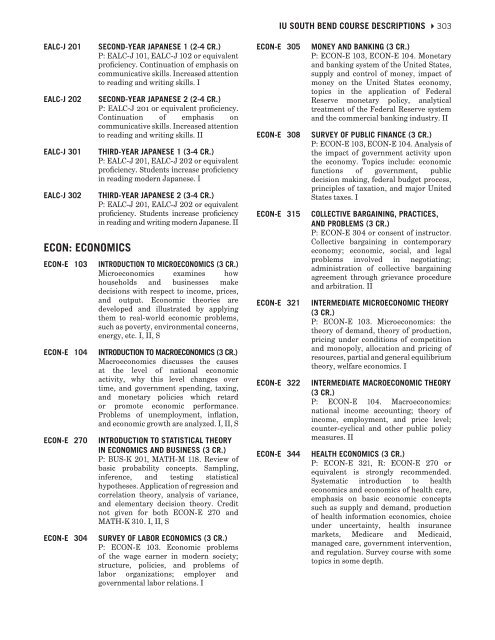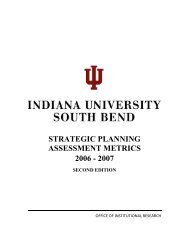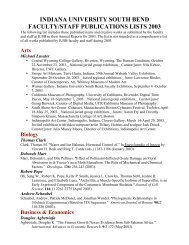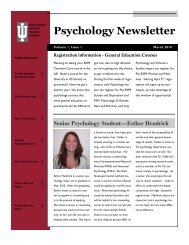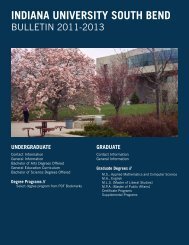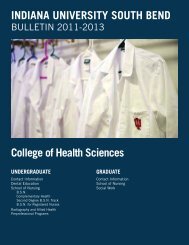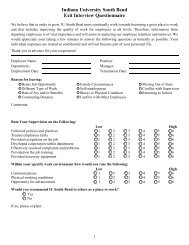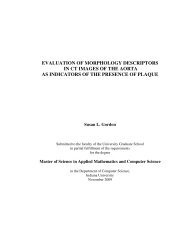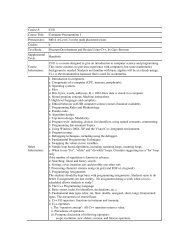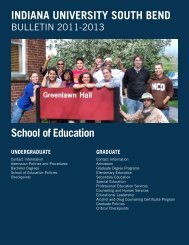INDIANA UNIVERSITY SOUTH BEND Course Descriptions
INDIANA UNIVERSITY SOUTH BEND Course Descriptions
INDIANA UNIVERSITY SOUTH BEND Course Descriptions
Create successful ePaper yourself
Turn your PDF publications into a flip-book with our unique Google optimized e-Paper software.
IU <strong>SOUTH</strong> <strong>BEND</strong> COURSE DESCRIPTIONS 4303<br />
EALC-J 201<br />
EALC-J 202<br />
EALC-J 301<br />
EALC-J 302<br />
ECON: ECONOMICS<br />
ECON-E 103<br />
ECON-E 104<br />
ECON-E 270<br />
ECON-E 304<br />
SECOND-YEAR JAPANESE 1 (2-4 CR.)<br />
P: EALC-J 101, EALC-J 102 or equivalent<br />
proficiency. Continuation of emphasis on<br />
communicative skills. Increased attention<br />
to reading and writing skills. I<br />
SECOND-YEAR JAPANESE 2 (2-4 CR.)<br />
P: EALC-J 201 or equivalent proficiency.<br />
Continuation of emphasis on<br />
communicative skills. Increased attention<br />
to reading and writing skills. II<br />
THIRD-YEAR JAPANESE 1 (3-4 CR.)<br />
P: EALC-J 201, EALC-J 202 or equivalent<br />
proficiency. Students increase proficiency<br />
in reading modern Japanese. I<br />
THIRD-YEAR JAPANESE 2 (3-4 CR.)<br />
P: EALC-J 201, EALC-J 202 or equivalent<br />
proficiency. Students increase proficiency<br />
in reading and writing modern Japanese. II<br />
INTRODUCTION TO MICROECONOMICS (3 CR.)<br />
Microeconomics examines how<br />
households and businesses make<br />
decisions with respect to income, prices,<br />
and output. Economic theories are<br />
developed and illustrated by applying<br />
them to real-world economic problems,<br />
such as poverty, environmental concerns,<br />
energy, etc. I, II, S<br />
INTRODUCTION TO MACROECONOMICS (3 CR.)<br />
Macroeconomics discusses the causes<br />
at the level of national economic<br />
activity, why this level changes over<br />
time, and government spending, taxing,<br />
and monetary policies which retard<br />
or promote economic performance.<br />
Problems of unemployment, inflation,<br />
and economic growth are analyzed. I, II, S<br />
INTRODUCTION TO STATISTICAL THEORY<br />
IN ECONOMICS AND BUSINESS (3 CR.)<br />
P: BUS-K 201, MATH-M 118. Review of<br />
basic probability concepts. Sampling,<br />
inference, and testing statistical<br />
hypotheses. Application of regression and<br />
correlation theory, analysis of variance,<br />
and elementary decision theory. Credit<br />
not given for both ECON-E 270 and<br />
MATH-K 310. I, II, S<br />
SURVEY OF LABOR ECONOMICS (3 CR.)<br />
P: ECON-E 103. Economic problems<br />
of the wage earner in modern society;<br />
structure, policies, and problems of<br />
labor organizations; employer and<br />
governmental labor relations. I<br />
ECON-E 305<br />
ECON-E 308<br />
ECON-E 315<br />
ECON-E 321<br />
ECON-E 322<br />
ECON-E 344<br />
MONEY AND BANKING (3 CR.)<br />
P: ECON-E 103, ECON-E 104. Monetary<br />
and banking system of the United States,<br />
supply and control of money, impact of<br />
money on the United States economy,<br />
topics in the application of Federal<br />
Reserve monetary policy, analytical<br />
treatment of the Federal Reserve system<br />
and the commercial banking industry. II<br />
SURVEY OF PUBLIC FINANCE (3 CR.)<br />
P: ECON-E 103, ECON-E 104. Analysis of<br />
the impact of government activity upon<br />
the economy. Topics include: economic<br />
functions of government, public<br />
decision making, federal budget process,<br />
principles of taxation, and major United<br />
States taxes. I<br />
COLLECTIVE BARGAINING, PRACTICES,<br />
AND PROBLEMS (3 CR.)<br />
P: ECON-E 304 or consent of instructor.<br />
Collective bargaining in contemporary<br />
economy; economic, social, and legal<br />
problems involved in negotiating;<br />
administration of collective bargaining<br />
agreement through grievance procedure<br />
and arbitration. II<br />
INTERMEDIATE MICROECONOMIC THEORY<br />
(3 CR.)<br />
P: ECON-E 103. Microeconomics: the<br />
theory of demand, theory of production,<br />
pricing under conditions of competition<br />
and monopoly, allocation and pricing of<br />
resources, partial and general equilibrium<br />
theory, welfare economics. I<br />
INTERMEDIATE MACROECONOMIC THEORY<br />
(3 CR.)<br />
P: ECON-E 104. Macroeconomics:<br />
national income accounting; theory of<br />
income, employment, and price level;<br />
counter-cyclical and other public policy<br />
measures. II<br />
HEALTH ECONOMICS (3 CR.)<br />
P: ECON-E 321, R: ECON-E 270 or<br />
equivalent is strongly recommended.<br />
Systematic introduction to health<br />
economics and economics of health care,<br />
emphasis on basic economic concepts<br />
such as supply and demand, production<br />
of health information economics, choice<br />
under uncertainty, health insurance<br />
markets, Medicare and Medicaid,<br />
managed care, government intervention,<br />
and regulation. Survey course with some<br />
topics in some depth.


